
While undertaking some recent reorganization of my basement workshop in Elderbarndottir’s former house (she got married in November and moved to her husband’s house) I came across this nostalgic and beat-up picture from early 1977, hiding behind one of the shelving units. This French secretaire was my first really high-profile/high-value furniture restoration project at Schindler & Son of the Palm Beaches, where I started working in late 1974. Unfortunately I did not take any detailed pictures of projects at this point of my career – had this happened once I was a museum conservator the project would have been documented with hundreds of photographic images to go along with the written reports. I probably took a picture or two of the interior, it was spectacular. Bat that was almost 50years ago and cannot recall that detail.
Somewhere I have a picture of a Riesener cabinet from the same client, but that picture has not turned up yet.
Prior to this I did a lot of run-of-the-mill restoration for “ordinary” antiques along with a boatload of custom finishing and refinishing; before Schindler’s I was a “scratch and dent man” at a couple of furniture stores.
This project arrived in pieces in the back of Ambassador So-and-so’s Mercedes station wagon. The secretaire bore the inventory stamp of the Chateau de Saint Cloud. It should come as no surprise that the culture from which the word bureaucrat is derived should be punctilious about household inventories, but there you have it.
Over a period of a couple weeks, I reassembled it and made repairs to the rosewood and tulipwood veneers, then finally a couple of days of shellac pad polishing. “Pop” Schindler came almost every day to watch and guide me, it was on this project that he introduced me to hot hide glue.
This was a seed for my fascination with exquisite European furniture, especially of the French variety (along with our company’s work at the Wrightsman estate in Palm Beach and their furniture collection), and was truly the acorn from which my fascination with Roubo sprouted. It was also the prompting for me to embark down the career path of conservation; I entered that stream in 1981 at Winterthur Museum while I was a student in college.
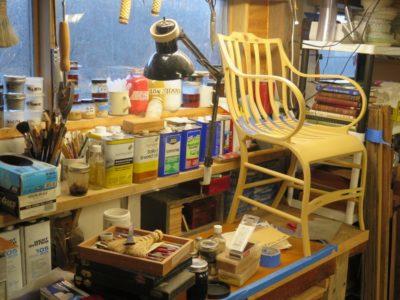
2023 is shaping up as a pretty Graggtastic year in the shop. I am in the home stretch of the copious pinstriping for one chair to be delivered. A second client’s chair is fabricated but I have not yet begun the painting, and a third chair is about half built.

Then last week I was contacted by someone who has a Gragg chair with a broken arm, and based on the images they sent it just *might* be ONLY THE THIRD ORIGINAL, COMPLETE ELASTIC ARM CHAIR known to exist!
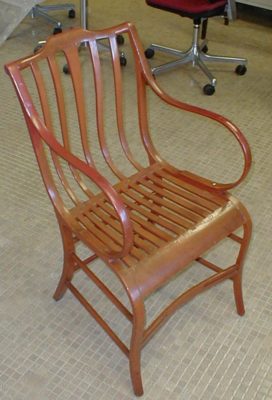
There is the completely overpainted chair at the SI that I kept in my conservation lab for almost two decades, trying unsuccessfully to persuade the curator to allow me to remove the overpaint.
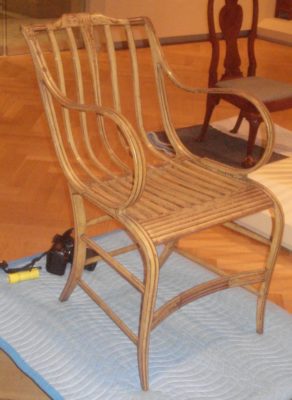
Then there is the beauty at the Carnegie in Pittsburgh, and the heavily restored one in Baltimore. Unfortunately at the moment I cannot find my overall photos of the BMA chair but I have a large folder of detail shots. As I understand it the Baltimore chair was missing some elements that were newly fabricated and integrated to make a whole chair.

This newest chair has a tricky repair to be made to the arm, and the putative client inquired about me making a new chair to make a pair with the old one.
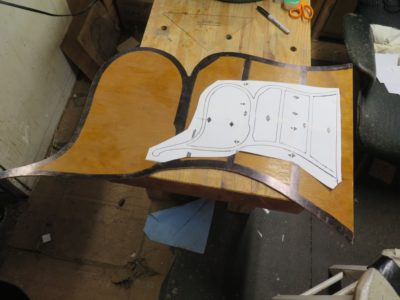
On top of all of this excitement there are several new Gragg-ish projects on the drawing board. Without revealing all the cards, consider that 1) we have a new grandson, and 2) the front porch of our Shangri-la cabin is rocking-chair-tastic.

Finally, I’m at long last seeing the light at the end of the tunnel for the “Build A Gragg Chair” video set. Whether that light is sunshine or an oncoming train I cannot yet be certain, but I remain hopeful. At the moment I am estimating the series to be more than a dozen half-hour-ish episodes, and Webmeister Tim and I are noodling the mechanism for the on-line offering. I’ve had one faithful donor sending me a small contribution every month (THANK YOU JimF!), but we need to come up with a system for processing the $1.99(?)/episode charge without viewers crawling up my back as the episodes are released. One approach I will almost certainly NOT take is a subscription model. I’ve spoken to some subscription-based content creators and they are unanimous in their regret. No matter how much content they create, their subscribers want more, and more often. I want no part of that.

Now the only thing left in the equation is the resolution to the question, “Why am I not as energetic and productive in my 68th year as I was in my 28th?”

‘Tis a mystery. Who knows, if I can solve that problem, I may even want to offer another Gragg chair workshop if there is interest.

Recently I learned that Fred Schindler died. This picture is us from 2013. I recount my earlier faulty conclusion about his demise here.
I have always considered him not only a dear life-long friend but my greatest mentor in the finishing/restoration trade as he hired me when I was 18 (?) and I worked for him off-and-on for five years (the “off” of that was when I moved to attend college). He said he always appreciated the fact that when I asked him for a job and he asked me what I could do, I replied, “I know how to sand and sweep the floor.” (I learned over time that guys asking for work would promise the moon regarding their abilities, always falsely.) I could do a little more than that after two years as a “scratch and dent man” but did not want to over promise my abilities, which were nowhere up to the standards of his shop. I knew of Schindler & Son because one of the furniture stores I had worked for used them for special custom finishing projects.
As far as I know Fred was pretty much self-taught but he was the best finisher I ever saw when it came to matching a new surface to an old one. And the business had plenty of old surfaces to work on, as probably the premier antique restorers for old money Palm Beach clients including Charles and Jayne Wrightsman whose collection of classical French furnishings was unparalleled. The business was so successful that the shop phone number was unlisted. The velocity of projects there was mind-numbing in retrospect; I probably restored/refinished a couple hundred antiques a year while working there. Conversely, while at SI I generally conserved a piece or two, maybe three or four, every year. The wealth of that experience at Schindler & Son formed a foundation for all my work ever since.
While Fred was selfless in transferring his knowledge and skills, his father Fernand (“Pop”) was a bit pricklier and reticent but even he and I formed a close bond. Being the victim of good upbringing, I treated Pop with respect and admiration, and he reciprocated by teaching more about marquetry and furniture making (especially ancient French Furniture) than I can even fully comprehend. Pop was retired by the time I came on the scene, but he showed up for a couple hours almost every day, guiding me through scores of restoration projects.
My regard for this father-and-son team is such that one of the Roubo books is dedicated to them.
With Fred’s death I have been recalling three other great work-related mentors of mine — Frank Tautzenberger, a curmudgeonly Hungarian immigrant who seemed about 200 years old and operated the warehouse corner repair shop in the first furniture store I ever worked and shuffled around in bedroom slippers making damage disappear; John Kuzma, the master of the foundry pattern shop who taught me about the meaning of precision; and Bert van Zelst, my long-time unit director at SI who showed me what disciplined curiosity looked like. Each of them imparted an unspeakable wealth of knowledge and insight, and oh the stories I could tell… Perhaps another day.
When I contemplate my own role as a mentor to other craftsmen and measure it against what these men did to for me, alas I come up short.
Farewell for now Fred, I will see you soon enough in Paradise.
Somewhere along the path Mrs. Barn picked up a rocking chair that I have managed to break three times, and is now destined for the kindling box down next to the woodstove. The first damage occurred when I put my behind through the aged embossed paper seat, which I replaced with some leather from my leather scrap drawer and some random upholstery nails. So far so good.
Last summer I sat in the chair and leaned back to rock and the proper right stile snapped off several inches above the seat, so off it went to the repair pile in the barn. The break was the worst type of damage, a cross-grain break in brittle wood.
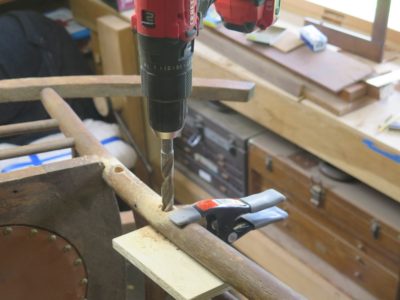
I spent portions of four days on this repair, first reintegrating the element with glue just to establish the previous configuration, then excavating in order to inset a beefy spline running several inches past the break in both directions. Though completely intrusive this is really the only way to regain any kind of structural integrity to a broken piece.
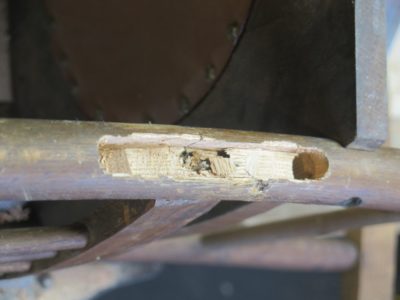
I observed during this process that this was perhaps the most brittle wood I had ever encountered, it was impossible to get a clean cut as the wood shattered as soon as I touched it with a newly sharpened tool.
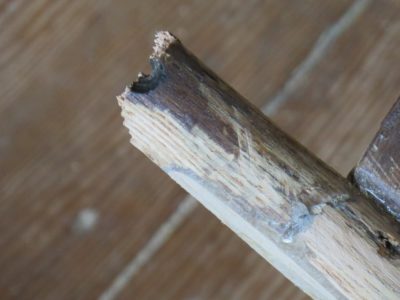
Once the spline was inset using epoxy adhesive I sat in the chair to make sure the repair would hold before I invested any time in the cosmetic work to make the repair disappear.

In a moment after putting my full weight on the chair the originally damaged stile snapped off about two inches below the inset spline, and the other stile immediately followed suit.

Sometimes you really are left with nothing but firewood. I’ll have to find a replacement because this was Mrs. Barn’s favorite porch rocking chair.
Busy day tomorrow, hospital check-in at 6AM (two hours away from us) knee surgery at 8:30 (hopefully, the covid swab on Saturday put my sinuses into full warpath mode ever since) probably cranky the rest of the day.


















Recent Comments